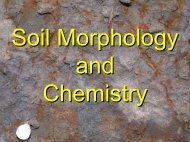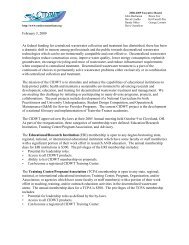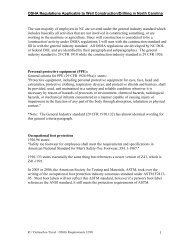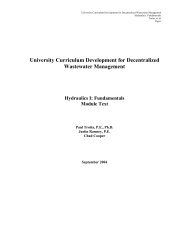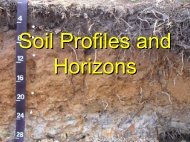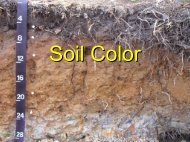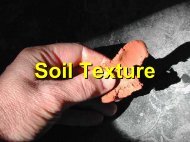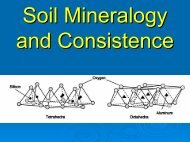Sedimentation
Sedimentation - Consortium of Institutes for Decentralized ...
Sedimentation - Consortium of Institutes for Decentralized ...
- No tags were found...
You also want an ePaper? Increase the reach of your titles
YUMPU automatically turns print PDFs into web optimized ePapers that Google loves.
<strong>Sedimentation</strong><br />
University Curriculum Development for Decentralized Wastewater TreatmentT<br />
Fundamental Concepts for Environmental Processes<br />
Kenimer et al., 13 August 2004<br />
FINAL
Acknowledgement<br />
This work was supported [in part] by the National<br />
Decentralized Water Resources Capacity Development Project<br />
with funding provided by the U.S. Environmental Protection<br />
Agency through a Cooperative Agreement (EPA No.<br />
CR827881-01<br />
01-0) 0) with Washington University in St. Louis. The<br />
results have not been reviewed by EPA or Washington<br />
University in St. Louis. The views expressed in this<br />
presentation are solely those of NCSU, and University of<br />
Arkansas and EPA and Washington University in St. Louis do<br />
not endorse any products or commercial services mentioned in<br />
the presentation.
<strong>Sedimentation</strong><br />
‣<strong>Sedimentation</strong><br />
is the gravitational<br />
accumulation of solids at the bottom of a fluid<br />
(air or water)
Types of Settling<br />
Four types of sedimentation:<br />
‣ Discrete settling<br />
‣ Flocculant settling<br />
‣ Hindered settling<br />
‣ Compression
Examples of Settling Types<br />
Discrete<br />
Flocculant<br />
Hindered
Types of <strong>Sedimentation</strong><br />
‣ In discrete settling<br />
individual particles<br />
settle independently<br />
‣ It occurs when there is<br />
a relatively low solids<br />
concentration
Types of <strong>Sedimentation</strong><br />
‣ In flocculant settling,<br />
individual particles<br />
stick together into<br />
clumps called flocs<br />
‣ This occurs when<br />
there is a greater solids<br />
concentration and<br />
chemical or biological<br />
reactions alter particle<br />
surfaces to enhance<br />
attachment
Types of <strong>Sedimentation</strong><br />
‣ In hindered settling,<br />
particle concentration<br />
is great enough to<br />
inhibit water<br />
movement<br />
‣ Water must move in<br />
spaces between<br />
particles
Types of <strong>Sedimentation</strong><br />
‣Compression settling<br />
occurs when<br />
particles settle by<br />
compressing the<br />
mass below
‣Stoke’s Law<br />
<strong>Sedimentation</strong> Rate<br />
‣Used for spherical particles<br />
‣Assumes no fluid mixing, so usually will not work<br />
for gasses<br />
v<br />
p<br />
=<br />
( ρ − ρw ) d<br />
p<br />
18µ<br />
2<br />
g
<strong>Sedimentation</strong> Rate<br />
v<br />
p<br />
=<br />
2<br />
( ρ − ρ ) d g<br />
p<br />
18<br />
‣ v p = particle settling velocity ( m / s or ft / s )<br />
‣ ρ p = particle density ( kg / m<br />
3 or lb / ft 3)<br />
‣ ρ w = fluid density ( kg / m 3)<br />
‣ d = particle diameter (m or ft)<br />
‣ g = gravitational acceleration (9.81 m / s<br />
2 or 32.2 ft / s 2)<br />
‣ µ = dynamic viscosity (Ns/m 2 or lbs/ft 2 )<br />
w<br />
µ
Applications<br />
‣Stoke’s Law can be used to determine the<br />
surface area of a settling tank<br />
‣Set the critical velocity equal to the settling<br />
velocity of the smallest particle<br />
‣The overflow rate is equal to the flow rate into the<br />
tank divided by the surface area<br />
‣Setting the overflow rate equal to the critical<br />
settling velocity allows time to capture smallest<br />
particles of interest
Applications<br />
OFR<br />
= v =<br />
c<br />
Q<br />
A<br />
‣OFR = over flow rate ( m / s or ft / s )<br />
‣v c = critical settling velocity ( m / s or ft / s )<br />
‣Q Q = the flow rate into the basin ( m3 / s or cfs)<br />
‣A A = the surface area of the basin (m 2 or ft 2 )





